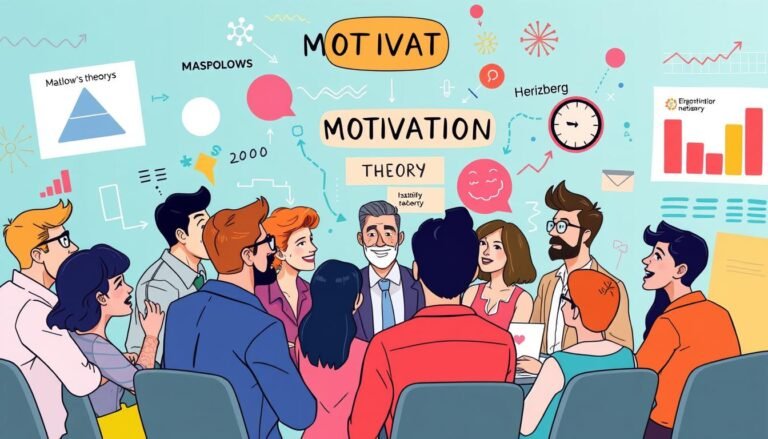Corporate Social Responsibility: How Organizational Psychology Creates Positive Impact
Can a company’s good deeds really shape its workforce? This question is at the heart of the growing link between corporate social responsibility (CSR) and organizational psychology. As businesses embrace ethical practices and sustainability, the effect on employee behavior and company culture is fascinating.
In today’s business world, CSR has become essential, not just nice. A huge 93% of the world’s biggest companies now report on their CSR efforts. This change shows that companies know their actions go beyond just making money.
Organizational psychology is key in understanding how CSR affects employees. Studies show that how employees see their company’s CSR efforts can greatly impact job satisfaction, engagement, and performance. This focus on the human side of corporate responsibility offers valuable insights.
We will dive deeper into how CSR influences a company’s identity, leadership, and stakeholder engagement. We’ll also look at the challenges companies face in implementing CSR and the trends that are changing corporate responsibility.
Key Takeaways
- 93% of major global companies report on CSR activities
- CSR significantly influences employee satisfaction and performance
- Organizational psychology provides insights into CSR’s human impact
- CSR shapes company culture and organizational identity
- Effective CSR implementation faces various challenges
- Emerging trends are reshaping the future of corporate responsibility
Understanding Corporate Social Responsibility
Corporate Social Responsibility (CSR) is now a big deal for companies all over the world. It means a company doing good things for society, not just making money. CSR has changed a lot, moving from just focusing on money to caring about people and the planet too.
Definition and Evolution of CSR
At first, CSR was all about making money. But now, it’s about more than that. It’s about being good to people and the environment too. This change is thanks to the triple bottom line idea, which says companies should make money, but also care for people and the planet.
Key Components of CSR
CSR has four main parts:
- Environmental responsibility: Reducing pollution and waste
- Ethical responsibility: Fair treatment of stakeholders
- Philanthropic responsibility: Charitable actions
- Economic responsibility: Financially-driven decisions benefiting society
The Growing Importance of CSR in Modern Business
CSR is becoming more important in business. Companies see that doing good is not just about money. A study by the Boston Consulting Group showed that companies that care about CSR are worth more than others.
| CSR Impact | Percentage |
|---|---|
| Brand Value Growth (High Impact Companies) | 175% |
| Brand Value Growth (Low Impact Companies) | 70% |
| Millennials Basing Job Decisions on Ethics | 44% |
| Gen Z Basing Job Decisions on Ethics | 49% |
These numbers show how important CSR is for attracting customers and employees. As people’s expectations grow, CSR will become even more key for companies to succeed.
The Intersection of CSR and Organizational Psychology
Corporate Social Responsibility (CSR) and organizational psychology have merged into micro-CSR research. This new field looks closely at how employees see and react to CSR efforts. It fills a big gap in CSR studies, which mostly looked at big pictures.
Micro-CSR research digs into how CSR affects employee motivation, self-image, and job purpose. It checks if personal values match company CSR actions. This mix opens up new areas for both fields.
- Over half of peer-reviewed CSR articles were published in the last decade
- Special issues on micro-CSR have appeared in journals like Personnel Psychology and Journal of Organizational Behavior
- 12 articles were published in Frontiers in Psychology’s Research Topic on CSR and organizational psychology
This focus on individual-level stakeholders is changing how companies handle CSR. Now, they think about how their actions impact employees, job seekers, and customers. They use more methods like experiments, interviews, and meta-analyses.
| Stakeholder Group | Focus Areas |
|---|---|
| Employees | Motivation, job satisfaction, organizational commitment |
| Job Seekers | Attraction to socially responsible companies |
| Customers | Perception of company values, brand loyalty |
As organizational behavior changes, micro-CSR research gives important insights. It connects theory and practice, helping companies build strong employee-employer bonds. This blend of CSR and organizational psychology leads to better performance and social good.
Employee Perceptions and Reactions to CSR Initiatives
Corporate Social Responsibility (CSR) initiatives are key in shaping how employees feel and act. Studies show CSR programs greatly affect job satisfaction, employee engagement, and commitment to the organization.
Impact on Job Satisfaction and Engagement
Research finds that employees prefer working for companies that care about social issues. CSR efforts make employees feel their values align with the company’s. This feeling of pride and purpose boosts engagement.
Influence on Organizational Commitment
CSR activities make employees more committed to their workplace. Seeing their company as socially responsible creates a strong bond. This bond leads to lower turnover rates and higher loyalty.
Effects on Employee Performance
CSR initiatives also improve employee performance. Studies show employees in CSR-focused companies work better and are more committed. This is because they feel motivated to contribute to a bigger cause.
| CSR Impact | Employee Outcome |
|---|---|
| High CSR Perception | Increased Job Satisfaction |
| Strong CSR Programs | Enhanced Employee Engagement |
| Authentic CSR Initiatives | Improved Organizational Commitment |
Knowing these connections helps companies create CSR strategies that work. These strategies improve the work environment and boost business success.
CSR and Organizational Identity
Corporate social responsibility (CSR) shapes how companies are seen and how employees feel about their work. Studies show that CSR makes employees more proud and loyal to their company. This shows how CSR can help build a positive work culture.
Research shows that how employees see CSR affects their job happiness and loyalty. A study in Pakistan found that CSR boosts a company’s reputation and employee commitment. This shows the power of CSR in improving workplace culture.
When a company’s CSR matches its core values, employees feel more connected and proud. Social identity theory explains that seeing CSR positively affects how employees feel about their company. This boosts their job satisfaction and commitment.
“CSR plays a crucial role in shaping how employees view and connect with their organization, ultimately influencing their performance and loyalty.”
Interestingly, the type of company culture also plays a role. Clan and adhocracy cultures help link CSR to a company’s reputation. This study shows that culture is key in making CSR work well.
As companies aim to build strong identities and engage employees, CSR is vital. It not only improves reputation but also makes employees more dedicated and involved.
The Role of Leadership in Promoting CSR
Leadership is key in shaping Corporate Social Responsibility (CSR) in companies. CSR leadership guides firms towards practices that help society and the environment.
Top Management’s Influence on CSR Implementation
Management’s role in CSR is huge. A study shows 90% of CEOs see CSR as vital for making ethical choices. This commitment from the top creates a culture of responsibility in the company.
Strong CSR leadership boosts employee engagement and keeps them around. Companies that focus on CSR see a 58% drop in employee turnover. This shows CSR’s positive impact on keeping talent and keeping the company stable.
Developing CSR-Oriented Leadership Styles
There are various leadership styles that can boost CSR. Transformational leaders motivate employees to adopt CSR values. Servant leaders focus on meeting stakeholder needs. Ethical leaders lead by example, setting the standard for responsible business.
| Leadership Style | CSR Focus | Impact |
|---|---|---|
| Transformational | Inspiring CSR vision | 63% higher employee engagement |
| Servant | Stakeholder needs | 76% boost in stakeholder satisfaction |
| Ethical | Responsible practices | 44% increase in customer loyalty |
Leaders who focus on CSR can lead big changes in their companies. They encourage a long-term view and involve stakeholders. This builds a strong base for sustainable and responsible business.
Corporate Social Responsibility and Stakeholder Engagement
Stakeholder theory is key to good Corporate Social Responsibility (CSR). Companies now see the value in talking to groups affected by their actions. This is shown by more environmental and social resolutions from shareholders, up from 368 in 2012 to 395 in 2013.
Community engagement is a big deal for many companies. Starbucks, for example, uses fair trade and sustainable coffee sourcing. This shows they care about farmers and customers. Patagonia also gets involved with “1% for the Planet,” making everyone feel responsible together.
Supply chain transparency is becoming more important in CSR. The California Transparency in Supply Chains Act of 2015 makes companies report on their suppliers’ conditions. This move is changing how businesses talk to stakeholders and manage their supply chains.
| Year | E&S Resolutions Filed | Average Shareholder Support |
|---|---|---|
| 2012 | 368 | 18.6% |
| 2013 | 395 | 21.7% |
More focus on stakeholder engagement is seen in rising support for CSR. Shareholder backing for environmental and social resolutions went up from 18.6% in 2012 to 21.7% in 2013. This shows how important it is for companies to match their values with what stakeholders want. This builds trust and boosts performance.
Measuring the Impact of CSR on Organizational Outcomes
Measuring CSR is key for businesses to see their social impact. They use financial and non-financial metrics to check their CSR work. This way, they get a full view of their efforts.
Financial Performance Indicators
Financial indicators give a clear number view of CSR’s impact. They include return on investment, stock price, and market share. Yet, they only show part of the story. A study of 17 studies found mixed results on CSR’s link to financial success.
Non-Financial Performance Metrics
Non-financial metrics give a wider view of CSR’s success. They cover employee happiness, customer loyalty, and environmental effects. Companies use KPIs to check progress in areas like reducing carbon footprint or increasing diversity in hiring.
ESG reporting offers a standard way to measure CSR. It mixes qualitative and quantitative data. This helps compare different CSR aspects.
| Measurement Method | Advantages | Challenges |
|---|---|---|
| Stakeholder Surveys | Direct feedback from affected parties | Subjective responses |
| Third-Party Assessments | Objective evaluation | Additional cost |
| Direct Impact Measurement | Comprehensive view of effects | Time-consuming |
CSR measurement faces challenges like attribution and long-term impact. Yet, it’s crucial. It guides data-driven decisions and helps improve social performance while meeting business goals.
Challenges in Implementing Effective CSR Strategies
Implementing CSR strategies is tough due to many barriers. Companies find it hard to link CSR with their main goals. This makes it hard to use resources well and have a big impact.
Another big problem is the lack of standard reporting tools. Without clear ways to measure, it’s hard for companies to show their CSR success. This is especially true for small and medium-sized businesses because of the cost and complexity.
Getting people in the company to accept change is also a big challenge. Some see CSR as extra work, not part of the job. To change this, companies need to improve how they talk about and teach CSR.
| Challenge | Impact | Potential Solution |
|---|---|---|
| Lack of strategic alignment | Ineffective resource allocation | Integrate CSR into core business strategy |
| Limited resources | Inadequate CSR implementation | Partner with other organizations for resource exchange |
| Stakeholder resistance | Slow adoption of CSR initiatives | Enhance communication and engagement programs |
To beat these hurdles, companies need to make CSR a key part of their plans. This way, social responsibility is part of every decision, not just an add-on. By tackling these issues, companies can make their CSR efforts more effective and lasting.
The Future of CSR: Trends and Predictions
CSR trends are changing fast, shaping how businesses handle their social duties. Looking forward, new areas of focus and tech advancements will change CSR practices.
Emerging Focus Areas in CSR
Sustainability innovation leads in CSR trends. Companies are now mixing social goals into their main business plans. This change comes from more people wanting to see real results in solving big problems.
- Impact measurement is on the rise, with firms developing sophisticated KPIs
- Employee volunteering programs promote diversity and inclusion
- Job purposing aligns employee roles with meaningful societal contributions
Integration of Technology in CSR Practices
Technology is changing CSR, making it easier to start and track efforts. AI and data tools help measure impact better. Virtual volunteering lets remote teams feel connected and purposeful.
“Companies that integrate CSR into their core business model are more resilient due to their purpose-driven culture that motivates and engages their stakeholders.”
As the world changes, CSR strategies are key for staying strong and growing. By following these trends and using tech, companies can make a big difference and also boost their profits.
Case Studies: Successful CSR Initiatives and Their Psychological Impact
CSR case studies highlight how big companies make a difference. Microsoft’s ‘Employee Volunteering’ program lets staff help nonprofits. This builds a culture of giving and boosts job happiness.
Patagonia’s 1% for the Planet pledge shows its eco-commitment. It makes workers proud to work there.
Salesforce’s ‘1-1-1 model’ donates equity, time, and products to good causes. This sparks employee engagement and attracts those who value social impact. Starbucks aims to cut waste by half by 2030, showing its focus on sustainability. Such goals inspire staff to think green in their daily work.
Google’s goal for 24/7 carbon-free energy by 2030 sets a high bar for environmental care. This bold target motivates employees to innovate for a cleaner future. These best practices in CSR not only help communities but also enhance employee well-being. Workers feel more connected to their company’s mission, leading to higher job satisfaction and loyalty.
Research backs up these positive effects. Studies show CSR initiatives boost employee engagement in healthcare and other sectors. They also reduce burnout and turnover rates. By investing in social good, companies create a win-win situation. They improve their public image while fostering a more committed, creative, and content workforce.
Source Links
- No title found
- CSR and Employee Happiness A Systematic Review and Critique of Organizational Cultures for Employee Satisfaction
- Frontiers | Corporate Social Responsibility and Collective OCB: A Social Identification Perspective
- What Is CSR? Corporate Social Responsibility Explained
- What Is Corporate Social Responsibility? 4 Types
- What Is Corporate Social Responsibility (CSR)?
- Corporate Social Responsibility and Organizational Psychology: An Integrative Review
- When Corporate Social Responsibility (CSR) Meets Organizational Psychology: New Frontiers in Micro-CSR Research, and Fulfilling a Quid Pro Quo through Multilevel Insights
- Employee-Perceived Corporate Social Responsibility (CSR) and Employee Pro-Environmental Behavior (PEB): The Moderating Role of CSR Skepticism and CSR Authenticity
- Frontiers | Employee perception of corporate social responsibility authenticity: A multilevel approach
- Frontiers | Scrutinizing Social Identity Theory in Corporate Social Responsibility: An Experimental Investigation
- Organizational Identity and Corporate Social Responsibility (CSR) Legitimation
- The impact of corporate social responsibility on firm reputation and organizational citizenship behavior: The mediation of organic organizational cultures
- The Impact of Corporate Social Responsibility on Leadership
- Ethical Leadership and Corporate Social Responsibility: Leading with Integrity and Impact
- The Corporate Social Responsibility Report and Effective Stakeholder Engagement
- CSR and Stakeholder Engagement: Building Trust in the Business Community – One More Tree Foundation
- Corporate Social Responsibility and Stakeholder Management
- CSR Impact Measurement Authoritative Guide | sopact
- Corporate social responsibility and performance in the workplace: a meta-analysis
- The Challenges of Implementing Social Responsibility
- What are the biggest challenges of implementing a corporate social responsibility strategy?
- What challenges are stopping you from implementing CSR?
- 2023 CSR Trend Forecasts
- Corporate Social Responsibility: The Top CSR Trends for 2024
- Top 10 Companies Leading the Way in Corporate Social Responsibility
- Companies Committing Social Good: 9 Real-World CSR Examples
- From Corporate Social Responsibility to Employee Well-Being: Navigating the Pathway to Sustainable Healthcare







